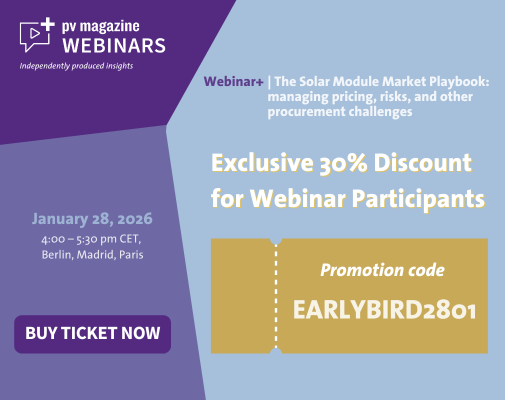Top News
WA backs Traditional Owners’ 5 GW green energy parks target

Carmaker uses repurposed EV batteries to help power production plant

BNEF flags potential global solar slowdown in 2026 as China cools
The pv magazine team wishes you happy holidays and a wonderful start to the new year!

SunRise Arabia Clean Energy Conference 2026
Join the 3rd SunRise Arabia Clean Energy Conference on April 22, 2026, in Riyadh to explore how solar PV and energy storage are powering the Kingdom’s growing digital economy — including data centers. Secure your spot at the early-bird rate.
Battery Business & Development Forum 2026
Connect with Europe’s energy storage leaders at the Battery Business & Development Forum 2026 in Frankfurt (March 31–April 1) and gain insights into evolving business models, financing strategies, and market trends
Out now - pv magazine Global Winter Edition
The new pv magazine Global edition is out now!
Available in print and digital – get your copy today!

Machine-learning models identify hidden physical defects in solar arrays

Neoen to tap new Telsa tech for South Australian battery project
European Energy lands tick of approval for 1.1 GW solar project
Flow Power reaches financial close on first standalone battery
Ambrion launches new all-in-one storage solutions
Press Releases
Watchdog denies $16 million in claims for ineligible upgrades
Riverina training centre to produce skilled workers to deliver energy transition
e-STORAGE to deliver 408 MWh battery for Vena Energy in South Australia
Arrival of 5 MWh energy storage system marks Jinko ESS’s continued expansion in Australia mining sector
Opinion & Analysis
Featured
Solar, wind and storage: stable prices, stable grid
Government pumps $5 billion into home battery program, issues persist
Over the weekend the federal government announced major changes to its $2.3 billion home battery subsidy program. The changes include nearly $5 billion in extra funding and adjustments to the financial support provided for different-sized batteries. They follow recent reporting that the program is subsidising unnecessarily large home batteries and blowing out in cost.
Post-COP30: Why distributed solar is becoming the world’s fastest-scaling power technology
Post-COP30 analysis has centred on the contentious debate over fossil-fuel phase-out wording. Yet the most significant development for the solar sector was not part of the negotiating text at all.
Household solar electricity generation in the Australian national accounts
The Australian electricity industry has transformed over the past two decades, driven by the rise of household solar and other renewable energy sources. Since 2010, supported by government incentives and improving technology, rooftop solar installations have surged.
Oversized batteries are blowing out Cheaper Home Batteries budget
The federal government’s $2.3 billion Cheaper Home Batteries Program is subsidising unnecessarily large energy storage systems and blowing out in cost.
Misleading chart overstates clean energy challenge
Primary energy – which refers to the raw energy in fuels and natural resources – is often used to show how much energy we use but as a measure it is misleading and makes the clean energy switch seem much harder than it actually is.
Markets & Policy
Featured
Potentia pushes energisation button on solar-battery hybrid project
Engie lights up Big Bash Leagues stadium with accredited GreenPower
French energy giant Engie will power all four Big Bash League cricket matches at the Engie Stadium, at the Sydney Olympic Park with government accredited GreenPower, starting 20 December 2025.
1 GW transfer capacity unlocked by existing Hunter region network upgrades
Electricity distributor Ausgrid will unlock 1 GW of transfer capacity from the Hunter-Central Coast Renewable Energy Zone by upgrading its existing distribution poles and wires, instead of building of building new ones.
Energy retailers operating in Victoria cop a record $24.5 million in penalties
The Victorian Essential Services Commission has fined energy retailers operating in Victoria a record $24,467,958 for consumer protection breaches, including overcharging.
First Nations groups encouraged to work with utilities to achieve solar on every household
First Nations Point Pearce Aboriginal Community in South Australia has negotiated with AGL Energy to have rooftop solar installed on every residents’ home, in a template First Nations Clean Energy Network encourages other communities to follow.
EnergyConnect transmission project records 10 million worker hours
Transgrid and Elecnor Australia, construction partners on the $4.1 billion, 700 kilometre EnergyConnect transmission project have clocked more than 10 million worker hours on the epic project involving the construction of over 1,000 transmission towers.
Installations
Featured
Aiko achieves 24.8% efficiency in commercial solar module production
Venergy completes 4.4 MW rooftop solar rollout for Stockland
Venergy Solar has completed what it says is one of the largest embedded network solar projects in Australia with 1,120 rooftop PV systems installed across four of property developer Stockland’s land-lease communities in Victoria.
GoodWe launches new hybrid inverters for C&I solar
The Chinese manufacturer has launched a new series of three-phase hybrid inverters ranging from 80 kW to 100 kW. The new products feature eight MPPTs with up to 42 A input current.
Facilitating DER/CER in Australia’s two-way energy system: report
The Australian Energy Regulator has released its third annual export services network performance report on facilitating consumer energy resources in Australia’s two-way energy system.
California winery runs all operations on floating and rooftop solar
A family-owned California winery has replaced grid electricity with onsite solar generation, reducing power costs and providing a live test site for floating photovoltaic research.
Renewables remain lowest-cost option says CSIRO report
The national science agency’s latest update on the cost of meeting Australia’s future power needs has again found firmed renewables provide the lowest-cost option for electricity generation.
Technology
Featured
All solar cell efficiencies at a glance – delayed
Researchers unmask fast charge potential of hard carbon anodes
Japanese researchers have found sodium-ion batteries using hard carbon anodes can intrinsically charge faster than lithium-ion batteries, challenging long-held assumptions in battery research.
$994 million in contracts granted for Marinus Link Stage 1
Marinus Link has awarded $994 million in contracts as part of the TasVic Greenlink joint venture of DT Infrastructure and Samsung C&T Corporation to deliver the balance of works package for Stage 1.
Back contact perovskite solar cell efficiency improved with breakthrough research
South Korean researchers have developed a novel bilayer tin oxide electron transport layer for improving efficiency and stability of back-contact solar cells.
The impact of transparent conductive electrodes on perovskite-silicon tandem solar cell performance
An Oxford researcher has found that transparent conducting electrodes can reduce perovskite–silicon tandem solar cell efficiency by over 2%, with losses linked to electrical resistance, optical effects, and geometric trade-offs. Using a unified optical–electrical model, the scientist showed how careful optimisation of TCE stacks, coatings, and cell design is critical to closing the gap toward the 37%–38% efficiency frontier.
IND targets global rollout of grid fault detection technology
IND Technology, the electricity grid safety start-up that was spun out of RMIT, has raised $50 million to help accelerate the global rollout of the company’s early fault detection technology.
Manufacturing
Featured
Research reveals impact of laser-assisted firing on TOPCon solar cell performance
SEG Solar starts building 3 GW solar ingot, wafer factory in Indonesia
United States-headquartered SEG Solar is constructing a 3 GW ingot and wafer factory in Indonesia. The new production facility is located at its existing cell manufacturing plant, completing an end-to-end solar manufacturing chain for the company.
Gokin Solar launches new back-contact solar module series
Gokin has launched back-contact solar modules ranging from 480 W to 780 W for residential, commercial, industrial, and utility-scale projects. The series supports 1,500 V systems and reaches efficiencies of up to 24.8%.
Astronergy launches 750 W anti-dust TOPCon solar module
The Chinese manufacturer said its new Astro 7 TOPCon module features an innovative self-cleaning frame and a power conversion efficiency of 23.2%.
Bad weather forecasts cost Australian solar energy sector $100 million: report
Solar energy forecasting company Solstice AI research has found a 10% improvement in weather / solar forecasting accuracy would generate an extra $38 million per year in profit for Australia’s utility solar, and worldwide, $9.5 billion.
Beijing group creates official entity to guide China’s polysilicon capacity
Industry analysts say a new Beijing-based coordination platform created by China’s top polysilicon producers signals a turn toward managed capacity, as the sector tries to halt a steep price slide and mounting consolidation pressures.
Energy Storage
Featured
Incat powers up world’s largest battery-electric ship
New tool tracks Australian government renewable energy investments
The agency tasked with helping manage Australia’s move to a net-zero economy has launched an interactive map featuring more than 800 Commonwealth-supported utility scale renewable energy and net-zero projects, transmission lines, and industrial projects.
Akaysha achieves major milestone with big battery now complete
Akaysha Energy, the battery storage platform backed by global funds giant Blackrock, has announced the completion of its first big battery project with the 155 MW / 298 MWh Ulinda Park energy storage system in Queensland now online.
Valent lands state planning approval for Armidale battery project
The New South Wales government has provided planning approval for the proposed $209 million Armidale battery project on the condition that developer Valent Energy invests more than $2.5 million in local community projects.
Iberdrola achieves connection milestone for Broadsound solar and battery build
The Australian arm of Spanish energy giant Iberdrola Iberdrola is poised to begin early testing of its Broadsound Solar Farm after Queensland transmission network operator Powerlink energised the grid connection to the 377 MWdc facility ahead of schedule.
Yanara names Gamuda to deliver massive solar and battery project
The Australian arm of Malaysian engineering group Gamuda has been tapped by renewables developer Yanara to deliver a 360 MW solar farm and 600 MWh battery energy storage project in southwest Victoria.




